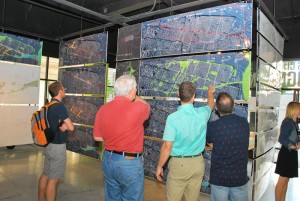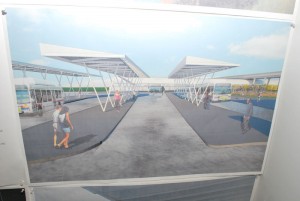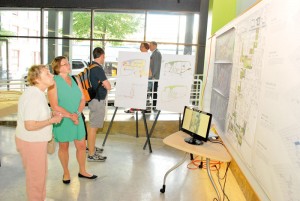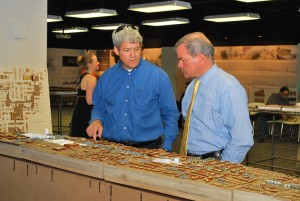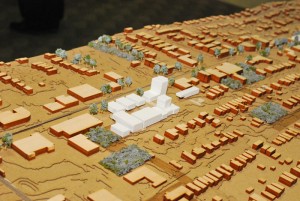By LESLIE COLLINS
Northeast News
June 19, 2013
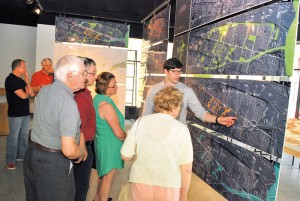
Community members filled the downstairs of the Kansas City Design Center (KCDC) in May, eyeing the walls plastered with maps, charts and designs for the Independence Avenue Corridor. Scattered throughout were the KCDC students, ready to provide more detail to attendees as well as explain their vision for Independence Avenue.
For one year, the 19 KCDC master’s students studied the Independence Avenue Corridor as part of their final project, which also folded into the $150,000 Planning Sustainable Places grant awarded to Historic Northeast from the Mid-America Regional Council (MARC). MARC commissioned the KCDC to study Northeast and create designs for different sections along the corridor.
Students studied everything from peak bus times to density and topography influences to area roads that affect Northeast and more. They met with Northeast stakeholder groups and incorporated ideas from those meetings.
On one side of the room, they displayed an 18-inch by 20-foot scale model they created of the Independence Avenue Corridor, where everything, including the buildings, were done to scale and shape.
“After a year, these students have worked so hard to bring together these renderings, this art, these great ideas for the future,” Northeast Kansas City Chamber of Commerce President Bobbi Baker-Hughes said. “This project brought the opportunity to collaborate with each other within our own community, with the city and with other partners.”
“What inspired this project to a significant degree is the stakeholder group,” said Vladimir Krstic, KCDC professor. “They were truly an inspiration for this project. They’re a group of people who are so committed to their place and want to see improvement. They’re really invested in it.”
The stakeholder group included the Northeast Kansas City Chamber of Commerce, Northeast Alliance Together (NEAT), the Mattie Rhodes Center, The Don Bosco Centers and the North-East Public Library.
Krstic asked his students to take ownership of the project and they rose to the challenge, he said. They became invested in the community and truly listened to the stakeholder groups to form their designs, he said.
One aspect that impressed Eric Wencel, a KCDC regional and community planning master’s student, is Northeast’s community involvement.
“Northeast Kansas City has so much energy,” Wencel said. “There’s so much community involvement and everybody really does seem to care about the neighborhoods and what’s happening on Independence Avenue. Everybody’s got this vision of what they want it to be.”
“What I liked most was being in a collaborative environment,” said KCDC interior architecture master’s student Carissa Loehr,” being able to work on something that was very real, that had very real issues and very real people attached to those issues… At first it was very intimidating to realize the scope of the work, but when it’s all said and done, there’s a huge sigh of relief to know this is actually making a difference. It’s really rewarding. Though there were many late nights, it was definitely worth it.”
Some of the design ideas include using strategic infill, planning for the future and creating a transportation hub underneath the Armour bridge for light rail and the streetcar, repurposing the shuttered former Thacher Elementary School into a performing arts space and reworking streets to better connect Northeast to downtown.
Strategic infill can vary, Loehr said. For some infill, the strategy would be to rebuild and offer services like dental care, medical care, daycare, occupational services, among others. For other sites, infill could include urban agriculture or pocket parks where the community could gather.
One of the goals is to better connect Northeast to downtown Kansas City, the River Market and Columbus Park. One proposal is to change Admiral Street into a two-way street to create better access to downtown and re-work the intersection at The Paseo and Independence Avenue to improve traffic flow and make it more pedestrian-friendly.
In August, all of the data and designs will be published in a book and made available to the city.
“What I really hope is they can take these ideas, the energy and some of the plans we developed and run with those and create something that can really happen as a physical entity along the avenue, instead of just a vision on paper,” said Chris Gillam, a KCDC architecture master’s student.
“This is just the stepping stone,” Loehr said. “From here only good things can happen and only more prtogress and development can occur.”


